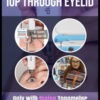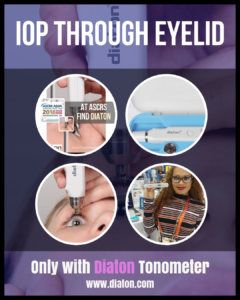Authors: Jessica Liu; Thasarat Vajaranant; Maria Cortina; Jacob Wilensky
Department of Ophthalmology and Visual Sciences, University of Chicago, Chicago, IL School of Medicine, Saint Louis University
Investigative Ophthalmology & Visual Science June, Vol.54, 3472. doi:
Agreement among Transpalpebral, Transcleral and Tactile Intraocular Pressure Measurements in Eyes with KPro Type 1 Boston Keratoprosthesis
Purpose: The use of keratoprostheses (KPro) to restore vision in eyes with corneal opacities has become increasingly popular in the last five years. Intraocular pressure (IOP) is a cardinal measurement employed in glaucoma management. This presents a major problem since glaucoma remains a major visual limiting factor in eyes with KPro and most forms of tonometry require an intact cornea. The purpose of this study is to determine if transpalpebral IOP measurement can be an alternative method of measuring IOP and yield valuable data in eyes with KPro.
Methods: We retrospectively reviewed IOP measurements in patients who had received Type 1 Boston KPro, and their IOP were estimated by three different methods during routine visits to their corneal surgeon. The surgeon estimated the IOP range tactilely by palpation of the globe. A pneumatonometer (Model 30 Classic; Mentor, BioRad, Santa Ana, California, USA) was used to measure IOP by placing the tonometer tip on the sclera peripherally to the contact lens in the inferotemporal quadrant. The Diaton tonometer (BiCOM, Inc., Long Beach, NY, USA) was used to obtain values through the upper lid in accordance with the instructions by the manufacturer. An average of two Diaton IOP measurements was used in the analysis. Since the tactile IOP were recorded as a range rather than a definite number, we computed the percent agreement, the percentage of eyes in which pneumatometer or Diaton IOPs were within 2 mmHg of the tactile IOP range. Two-tailed t-test was used to compare the mean of pneumatonometer and Diaton IOP measurements.
Results: The analysis included 23 eyes of 20 patients. The percentage agreement was 85% between tactile range and pnematonometer IOPs, and 95% between tactile range and Diaton IOPs. Pneumatonometer consistently yielded higher IOP values, compared to Diaton (p = 0.04). The overall IOP mean ± SD was 17.2 ± 6 mmHg for pneumatonometer and 13.8 ± 5 mmHg for Diaton tonometer.
Conclusions: The presence of KPro did not appear to interfere with IOP with Diaton tonometer, and Diaton tonometer yielded IOP readings that were similar to those obtained by palpation. Scleral pneumotonometry yielded values that were consistently higher than tactile estimates and Diaton IOP. In addition to routine IOP estimates by palpation, transcleral and transpalpebral IOP measurements can be considered to monitor patients with KPro.
 Keywords: Tonometry, Scleral Tonometry, transpalpebral, diaton tonometer, Keratoprosthesis, Boston KPro, Tonometer
Keywords: Tonometry, Scleral Tonometry, transpalpebral, diaton tonometer, Keratoprosthesis, Boston KPro, Tonometer
Learn more about Transcleral Diaton Tonometer: www.TonometerDiaton.com








